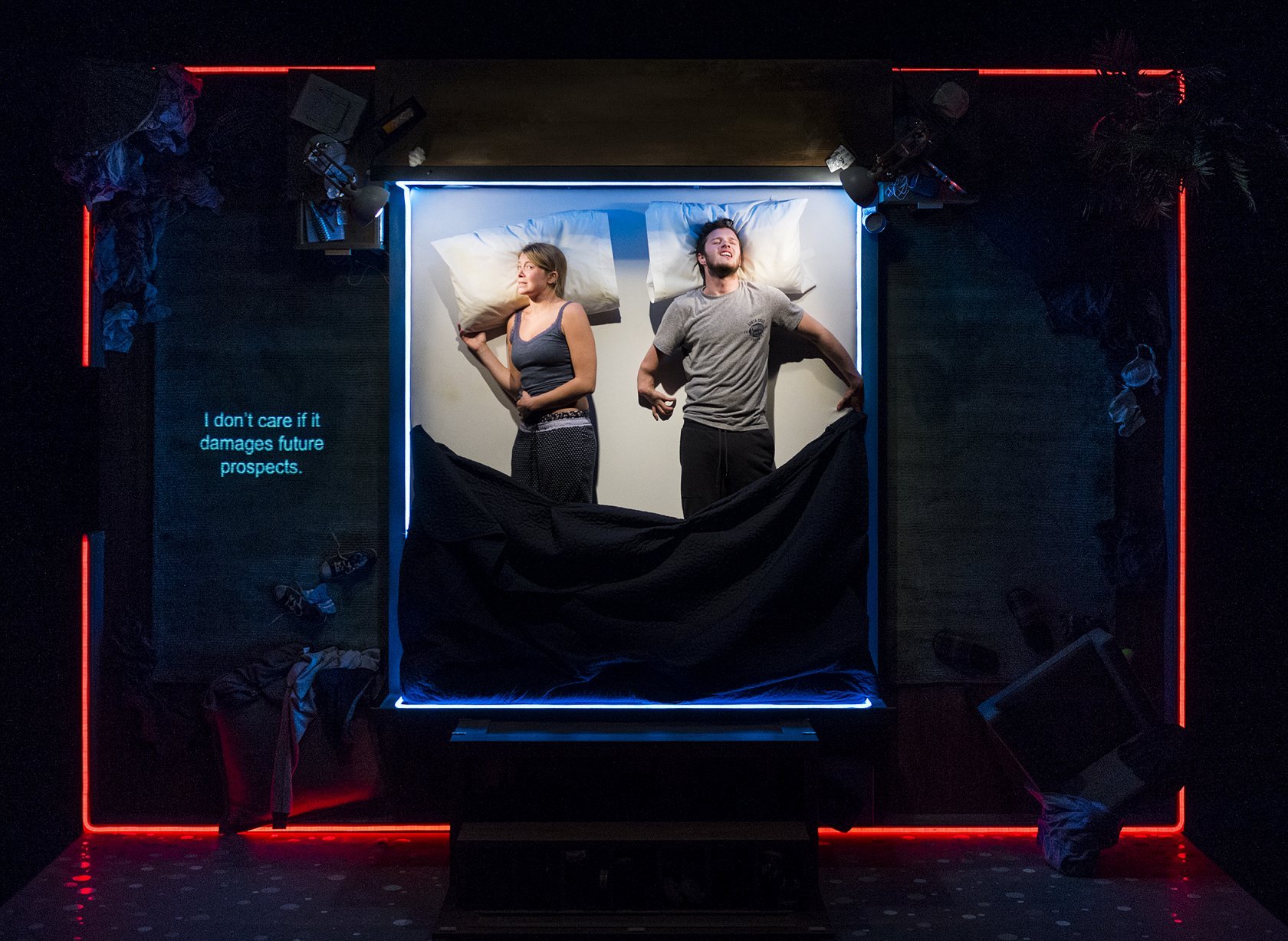
A scene with captions for ‘The Solid Life of Sugar Water’
Photo: Patrick Baldwin
Playing with form
To make theatre truly accessible, elements such as captioning and audio description must have their own artistic stamp, says Amit Sharma.
As I write this, I’m sitting in a room full of writers at the Octagon Theatre in Bolton. At Graeae we are in the second year of Write to Play, our new writing programme for five writers to connect with new writing powerhouses across the country. This year our partners are Royal Exchange Manchester and Liverpool Everyman, as well as the Octagon, and next year we will partner with theatres in the north east.
It was the first time I fully understood the concept of the social model of disability and having it practically played out in front of me
The conversation taking place centres around form: How much should a writer think about how form effects their play? It’s a fascinating conversation with many different writers given as examples to either read or to go and see. I hold back until the conversation is heading to a conclusion and then input to the writers about the aesthetic that we use. For those new to our work, Graeae places Deaf and disabled artists centre stage and has been doing so for the last 35 years. The nature of the artists we work with brings a plethora of different communication styles which then feed into our artistic productions and work. This includes making sure that the British Sign Language (BSL) translation is clear and makes sense within the context of the scene, looking at how we can make the creative captioning fit stylistically within the play, and scripting the preamble and full audio description for blind and visually impaired members of the audience in a way that has its own artistic stamp. This is done alongside rehearsing the play within a standard four-week period. There’s no time to waste. This process feels completely natural and is fundamental in making our work fully accessible, but what is artistically familiar to us can still be new territory for audiences and artists alike.
This was highlighted when I opened The Solid Life of Sugar Water by Jack Thorne at The Drum, Plymouth, which is about to hit the Edinburgh Festival. The show has no BSL but does contain creative captioning and audio description. These elements were not prescribed in the script beforehand. In fact, there was no obvious disabled element at all. It was in the rehearsal room where we figured out what the access requirements were to make the work accessible.
But what if you have no access requirements? How does that effect what your experience is? I’d like to think that we’re creatively challenging the status quo. The accessible elements are intrinsic to the set, the actors and the play. To use an example, in Sugar Water we don’t place the creative captioning in one location. This is so that it doesn’t become boring for a non-disabled audience or tiring to look at for a Deaf audience. The different placement has a creative logic behind it so the drive behind it is the art. It brings great joy when you can achieve multiple things when only using one specific element.
I’ve been using this artistic, aesthetic form for a long time both as an actor and director. When I first came into contact with Graeae, it was on an actor training programme called the Missing Piece, which gave opportunities to Deaf and disabled people that weren’t being provided by drama schools at the time. Being part of Missing Piece gave me a lot of firsts. It was the first time I had been in a room with so many Deaf and disabled people. It was the first time I fully understood the concept of the social model of disability and having it practically played out in front of me. Crucially, it was the first time I saw the aesthetics of access and experienced how thrilling it could be. All this was underpinned by an equal opportunity for all.
Even though great strides have been made to make courses accessible, it can still be difficult for Deaf and disabled people to get a place, as some elements of training are very specific, particularly voice and movement. So our next big training initiative will be the ‘Ensemble’ which will give young Deaf and disabled people the tools and skills to become freelance theatre practitioners by having both a learning and practical experience with a variety of different organisations. This, accompanied with our initiative Young Artistic Advisors, gives us a solid foundation to keep discovering and supporting the next generation of artists.
It’s a really exciting time to be part of the company, but it is tempered with the chronic situation Deaf and disabled people are facing in our everyday lives. The uncertainty around the disability support allowance for disabled students – the arbitrary caps and inconsistencies of Access to Work and the closure of the Independent Living Fund – is incredibly upsetting. We have come so far and fought so many battles for our right to be independent both in study, life and work. This isn’t about care. It’s about equality of opportunity.
That’s why I relish the conversations about form or structure or what empassions writers to write. These conversations are about the art and there is little talk about people hiding impairments to progress in their careers whether they are at the beginning, middle or at the end. It’s a forum to share ideas, listen and learn, and to produce the best possible work. Just like any other artist.
Amit Sharma is Associate Director at Graeae Theatre Company.
www.graeae.org
Join the Discussion
You must be logged in to post a comment.